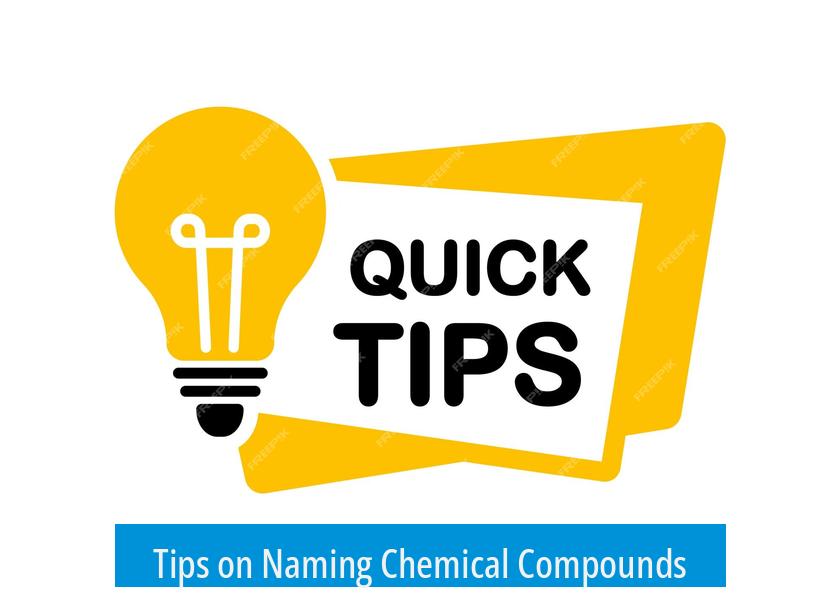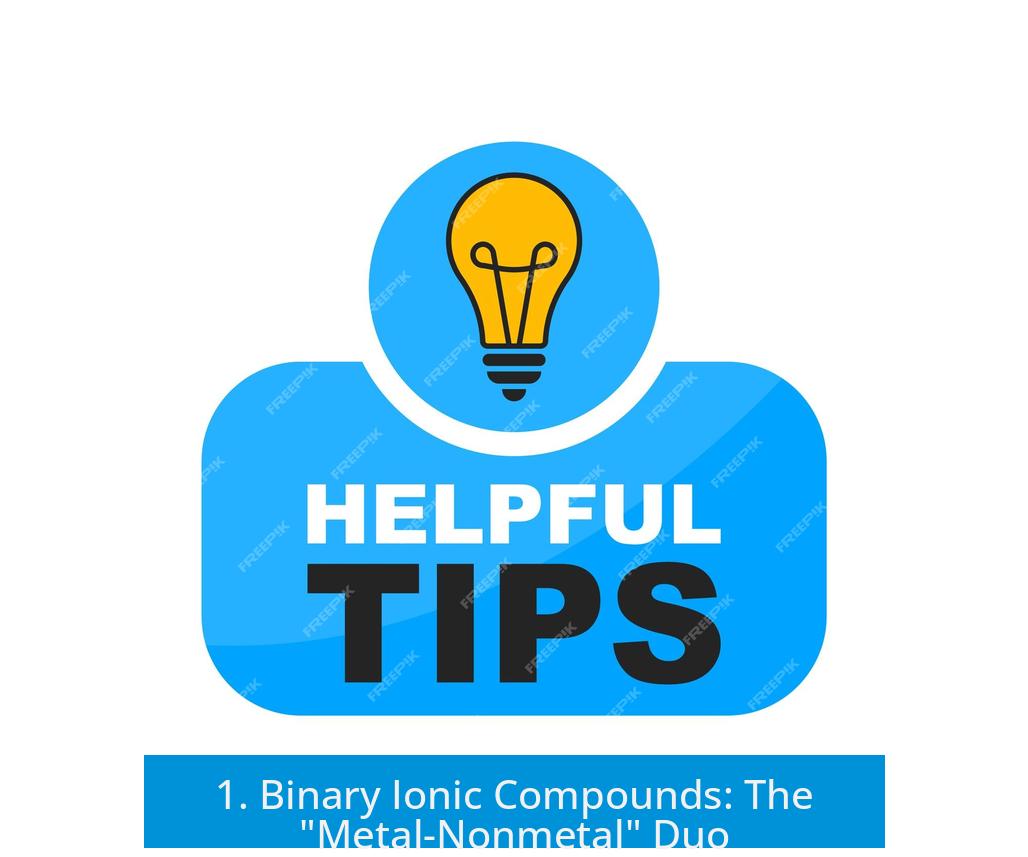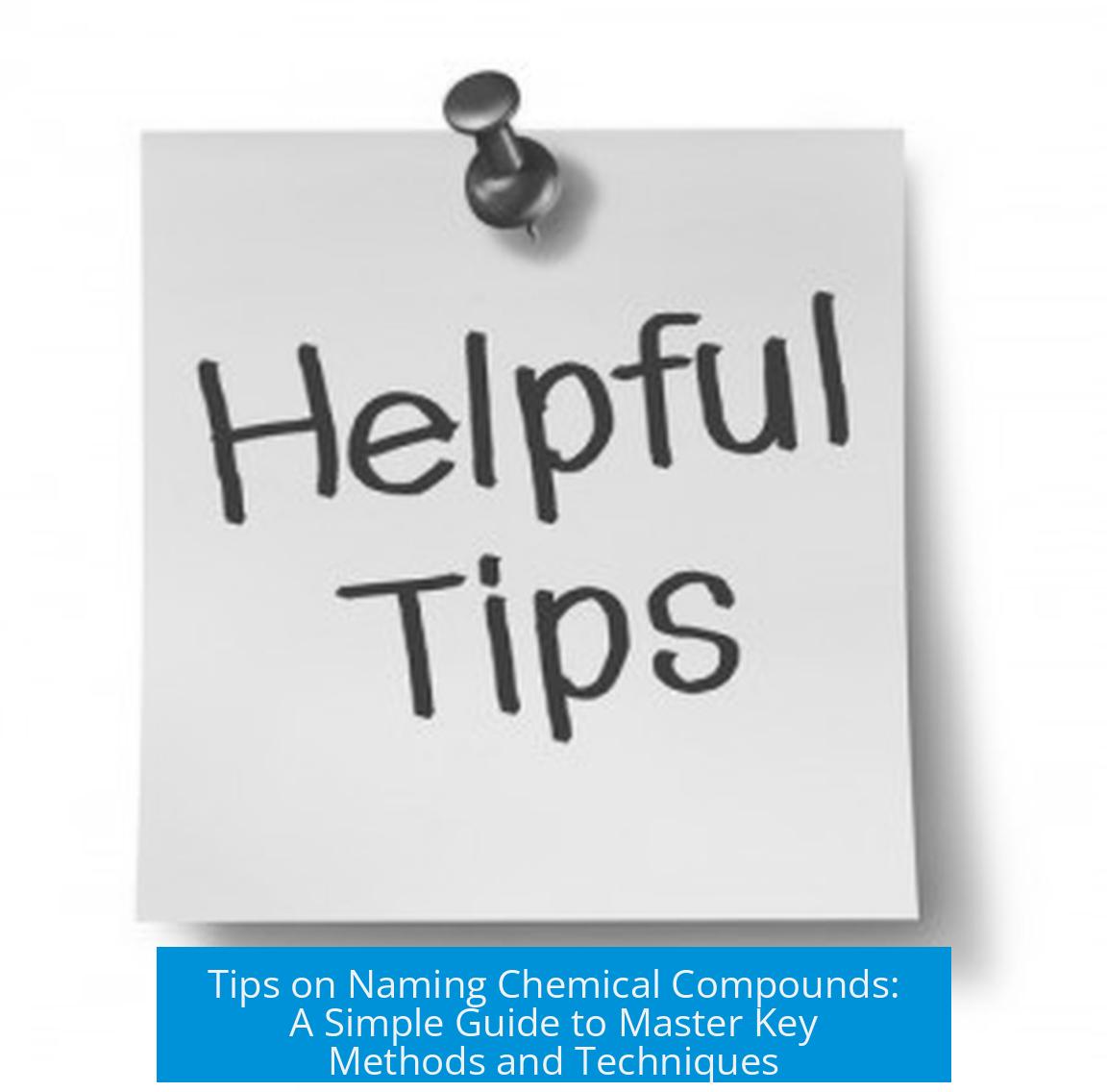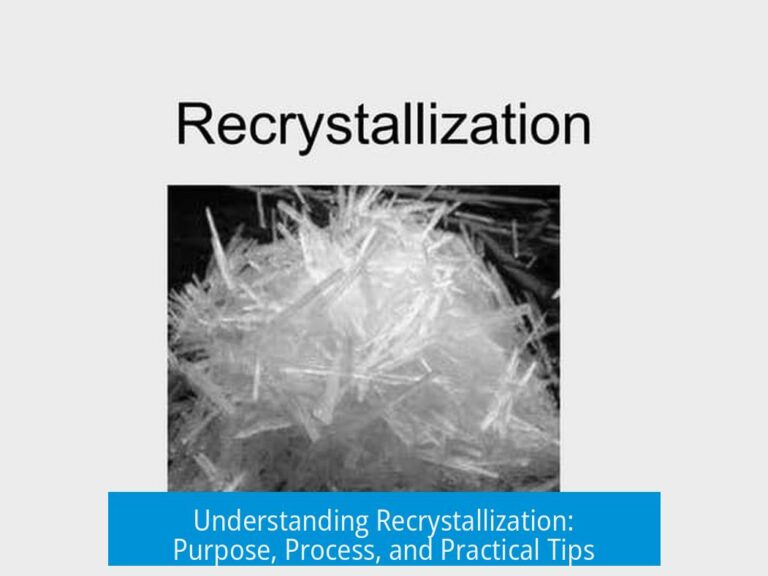Tips on Naming Chemical Compounds

Naming chemical compounds follows specific rules depending on the type of compound involved. These rules help in identifying the compound’s composition and structure from its name. Compounds are broadly categorized as binary ionic, binary molecular, ternary ionic, and acids. This article outlines practical tips and examples for each category.
1. Naming Binary Ionic Compounds
Binary ionic compounds consist of one metal and one nonmetal. The naming starts with the metal (cation) followed by the nonmetal (anion). The anion’s name ends with the suffix -ide.
- Name the metal first, unchanged.
- Name the nonmetal second, replacing the ending with -ide.
Example: NaCl is named sodium chloride. Sodium is the metal, chloride is the nonmetal with the -ide ending.
2. Naming Binary Molecular Compounds
These compounds contain two nonmetals. Both elements receive prefixes indicating the number of atoms present, based on their subscripts. The first element’s prefix “mono-” is often omitted.
- Name the first element with a prefix if more than one atom is present.
- Name the second element using a prefix always and change its ending to -ide.
- Use the following prefixes:
| Number | Prefix |
|---|---|
| 1 | mono |
| 2 | di |
| 3 | tri |
| 4 | tetra |
| 5 | penta |
| 6 | hexa |
| 7 | hepta |
| 8 | octa |
| 9 | nona |
| 10 | deca |
Example: H2O is named dihydrogen monoxide. Although “mono-” is usually dropped on the first element, it is retained here for clarification in teaching contexts. CO is named carbon monoxide.
3. Naming Ternary Ionic Compounds
Ternary ionic compounds contain a polyatomic ion. Polyatomic ions commonly end with -ate or -ite. The compound is named by stating the cation first and the polyatomic anion second.
- Identify the cation (usually a metal).
- Name the polyatomic anion (look for -ate or -ite endings).
- Note exceptions, such as hydroxide.
Example: HClO4 is named perchloric acid when dissolved in water. Here, perchlorate is the polyatomic ion, and the acid’s name reflects the anion.
4. Naming Acids

Acids typically contain hydrogen at the start of their formula. Their naming depends on the anion attached to hydrogen.
- If the anion ends in -ide, the acid name starts with “hydro-” and ends with -ic acid.
- If the anion ends in -ate, the acid name ends with -ic acid without “hydro-.”
- If the anion ends in -ite, the acid name ends with -ous acid.
Example: HCl (chloride ion) is named hydrochloric acid. HClO4 (perchlorate ion) is perchloric acid.
Additional Advice
Mastering chemical nomenclature requires regular practice. Online resources and textbooks such as IUPAC nomenclature guidelines help learners understand naming conventions.
In organic chemistry, detailed names can be less critical. Chemists often use structural descriptions and scaffolds instead of full systematic names. However, precise naming remains important for standardized communication, exams like the MCAT, and legal documentation such as patents.
The key to effective naming lies in understanding the rules, recognizing patterns in compound categories, and applying prefixes and suffixes accurately.
Key Takeaways
- Binary ionic compounds: metal (cation) named first, nonmetal (anion) named second with -ide suffix.
- Binary molecular compounds: use prefixes to indicate atom numbers; add -ide to the second element; omit “mono-” for the first element.
- Ternary ionic compounds feature polyatomic ions ending in -ate or -ite; name cation first and polyatomic anion second.
- Acids are named based on their anion; the presence of hydrogen and anion type dictate the suffix and prefix.
- Practice and reference materials improve naming accuracy, which is vital for exams, academic writing, and patent processes.
Crack the Code: Tips on Naming Compounds That Actually Make Sense
Ever stared at a chemical formula and thought, “How on earth do I turn this gibberish into words?” You’re not alone. Naming compounds can feel like decoding alien language. But naming compounds follows clear rules that anyone can grasp. Let’s break down these tips with neat tricks and no-nonsense examples.
1. Binary Ionic Compounds: The “Metal-Nonmetal” Duo

Here’s the scoop: binary ionic compounds consist of exactly two types of elements—one metal and one nonmetal. First, you name the metal (the cation) as it appears on the periodic table. Easy so far.
Next comes the nonmetal (the anion), but with a twist: you chop off its ending and slap on -ide. This little suffix tells everyone, “Hey, this is an anion!”
Example: NaCl becomes sodium chloride. Sodium is the metal; chloride is chlorine’s anion form.
Need more examples? Potassium bromide (KBr) or magnesium oxide (MgO) follow the same rule. It’s like naming your favorite band: the lead singer first (metal), the backup group last (anion with -ide).
2. Binary Molecular Compounds: When Two Nonmetals Dance
Two nonmetals? Time to bring in the prefixes—mono, di, tri, and friends (up to deca). These prefixes count just how many atoms each element brings to the party.
Rule number one: Name the first element and only use “mono” if you really need to (it’s polite to skip it when there’s just one). Then, the second element always gets a prefix plus an -ide ending.
| Number | Prefix |
|---|---|
| 1 | mono |
| 2 | di |
| 3 | tri |
| 4 | tetra |
| 5 | penta |
| 6 | hexa |
| 7 | hepta |
| 8 | octa |
| 9 | nona |
| 10 | deca |
Example time: H2O is dihydrogen monoxide (but since it’s so well-known, we usually say “water” or just “hydrogen oxide”). CO is carbon monoxide. Notice “mono” sneaks in only on the anion.
3. Ternary Ionic Compounds: Dealing with Polyatomic Players
Now it gets a tad more complex with ternary ionic compounds, where at least one polyatomic ion (a group of atoms acting together) enters the scene. These particular ions end in -ate or -ite.
In naming these, start with the cation (like before), and then say the polyatomic ion’s name without changes. Some exception ions like hydroxide do their own thing, so keep an eye out.
Example: HClO4 is named perchloric acid when in aqueous acid form. Here, chlorate ion’s variations play a role.
This might sound intimidating, but spotting those -ate and -ite endings is a great shortcut to getting it right.
4. Naming Acids: The Hydrogen Front
Acids almost always begin with hydrogen atoms in their formulas. To name an acid, you often just name what’s left after hydrogen—usually an anion—and tweak the ending accordingly.
For acids derived from polyatomic ions ending in -ate, swap the ending with -ic acid. For -ite, change it to -ous acid. It’s a nifty linguistic flip!
Example: HClO4 is perchloric acid, as seen earlier.
Few exceptions exist, but the rule mostly holds. So, next time you see an acid formula, just remember: hydrogen upfront, anion tweak afterward.
Practice Makes Perfect: The Real MVP of Naming Compounds

Here’s a truth bomb: memorizing rules is only half the battle. Chemistry naming conventions reveal their charm only with practice. Flashcards, quizzes, and real-life examples turn those rules from confusing mumbo jumbo into muscle memory.
Don’t sweat the finer organic chemistry nomenclature if your focus isn’t that deep. Many organic chemists prefer referencing structures or scaffolds rather than rigid names. But if you’re prepping for exams like the MCAT or tackling patent paperwork, mastering these rules is gold.
Pro tip: tap into free online resources like Wikipedia or chemistry databases. They’re treasure troves of examples, exceptions, and clear explanations. Naming compounds suddenly seems less like magic, and more like a skill anyone can wield.
Wrapping Up: Why Bother Naming Compounds Right?
Sure, it might feel like a tedious chore. But clear compound names mean everyone—from students to scientists—can communicate precise chemical info. It’s the language that turns formulas into universally understood stories.
Next time you wrestle with a chemical name, ask yourself:
- Is my compound metal + nonmetal? Use cation + anion (-ide).
- Got two nonmetals? Apply prefixes and add -ide.
- Is there a polyatomic ion? Look for -ate or -ite endings and name accordingly.
- Acid alert? Hydrogen up front and anion name tweak behind.
Stick to these steps, practice consistently, and soon you’ll be naming compounds like a chemistry ninja—with a little flair and a dash of confidence.





Leave a Comment